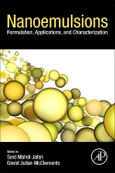Nanoemulsions: Formulation, Applications, and Characterization provides detailed information on the production, application and characterization of food nanoemulsion as presented by experts who share a wealth of experience. Those involved in the nutraceutical, pharmaceutical and cosmetic industries will find this a useful reference as it addresses findings related to different preparation and formulation methods of nanoemulsions and their application in different fields and products. As the last decade has seen a major shift from conventional emulsification processes towards nanoemulsions that both increase the efficiency and stability of emulsions and improve targeted drug and nutraceutical delivery, this book is a timely resource.
Please Note: This is an On Demand product, delivery may take up to 11 working days after payment has been received.
Table of Contents
Section 1: Nanoemulsion basics 1. General aspects of nanoemulsions and their formulation 2. Nanoemulsion properties
Section 2: Preparation of nanoemulsions by low-energy methods 3. Catastrophic phase inversion techniques 4. Transitional phase inversion techniques
Section 3: Production of nanoemulsions by mechanical methods 5. General principles of nanoemulsion formation by high-energy mechanical methods 6. Fabrication of nanoemulsions by rotor-stator emulsification 7. Fabrication of nanoemulsions by high pressure valve homogenization 8. Fabrication of nanoemulsions by microfluidization 9. Fabrication of nanoemulsions by ultrasonication 10. Fabrication of nanoemulsions using membrane emulsification
Section 4: Application of nanoemulsions 11. Application of nanoemulsions in foods 12. Application of nanoemulsions in chemicals, agrochemicals, and petrochemicals 13. Application of nanoemulsions in drug delivery 14. Application of nanoemulsions in cosmetics 15. Application of nanoemulsions in synthesis of nanoparticles
Section 5: Characterization and analysis of nanoemulsions 16. Characterization of particle properties in nanoemulsions 17. Characterization of physicochemical properties of nanoemulsions 18. Characterization of gastrointestinal fate of nanoemulsions
Section 6: Conclusion, future trends, and regulatory issues of nanoemulsions
Authors
Seid Mahdi Jafari Professor, Faculty of Food Science and Technology, Gorgan University of Agricultural Sciences and Natural Resources, Gorgan, Iran. Prof. Seid Mahdi Jafari received his PhD in Food Process Engineering from the University of Queensland (Australia), in 2006. He has been working on the nanoemulsification and nanoencapsulation of food bioactive ingredients for the past 15 years. Now, as a full Professor, he is an academic member of GUASNR (Iran) and Adjunct Prof. in UVigo (Spain). He has published more than 320 papers in top-ranked International Food Science Journals and 60 book chapters along with editing 36 books with Elsevier, Springer, and Taylor & Francis.In 2015, he was awarded as one of the top 1% world scientists by Thomson Reuters (Essential Scientific Indicators) in the field of Biological Sciences. In 2017, he was selected as one of the top national researchers by the Iranian Ministry of Science, Research, and Technology. He has been awarded as one of the world's highly cited researchers by Clarivate Analytics (Web of Science), in 2018, 2019 and 2020; and a top reviewer in the field of agricultural and biological sciences by Publons (2018 and 2019). D. Julian McClements University of Massachusetts, Amherst, MA, USA. Professor David Julian McClements works in the Department of Food Science at the University of Massachusetts, Amherst. He is well known for his research into lipid oxidation and antioxidants.








